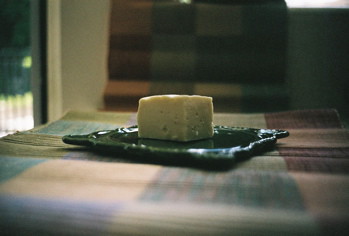
Here's the thing with a cheese plate - it's not just about cheese.
Sure, you can slice up some colby and mozzarella and call it a cheese plate, but give me a break. That's cheese on a plate, not a cheese plate.
A cheese plate is a work of art, a fanciful exploration of possibilities. It can go many directions, but to be correct, must remain balanced and pleasing in every aspect. The preparer - for no cooking is involved - must carefully select the cheese plate items for an experience of salty, creamy, sweet, crunchy, fruity, simple and complex.
There must be at least two cheeses, preferably three or more, of good quality and of a variety of flavors and textures. It helps if they aren't all cow's milk. One cow, one goat, one sheep is an interesting mix. Or one creamy, one semi-soft or firm, and one dry and crumbly.
My favorite would be either one brie or blue, one aged cheddar, and some kind of Pecorino or Parmesan.
The classic accompaniments are bread, fruits (fresh or dried) and nuts. Neglect not olives, though. A development I've seen recently is a blob of honey with comb served with a blue cheese. I like that.
At home, I get creative with different types of crackers, hearts of palm, several different olives, little pickles or cornichons, sliced sweet peppers, dabs of hummus. Dried fruits like raisins or apricots, a thinly-sliced apple.
Tonight's cheese plate featured:
Goat cheese gouda
A strong American blue cheese
Triscuits
Lucques Olives
Plain hummus
Hearts of Palm, sliced lengthwise
Walnuts coated with cocoa and chipotle powders
Apple, sliced thin
The lovely thing about making a cheese plate at home is that it turns cleaning out the fridge into an artistic, creative experience. The fridge and cabinets become sources of hidden treasure. Before, it was a just tablespoon of leftover walnuts. Now it is a cheese plate accompaniment! I am a culinary genius!

1 comment:
I could eat cheese and fruit everyday.
Post a Comment